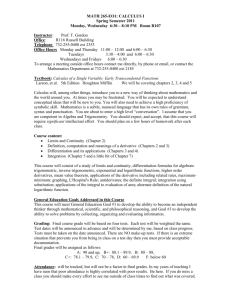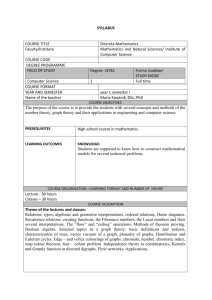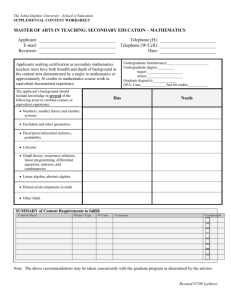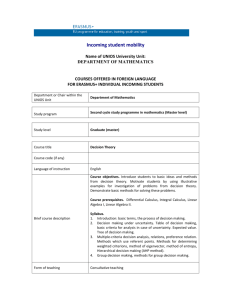TEACHING STATEMENT From the time I began
advertisement
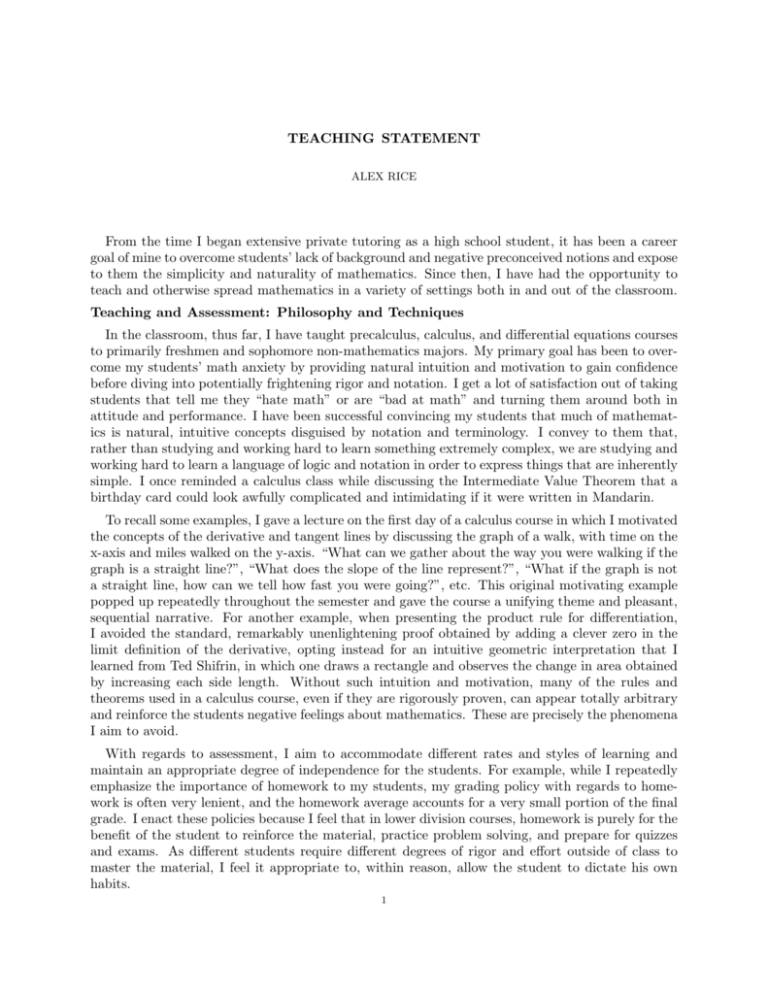
TEACHING STATEMENT ALEX RICE From the time I began extensive private tutoring as a high school student, it has been a career goal of mine to overcome students’ lack of background and negative preconceived notions and expose to them the simplicity and naturality of mathematics. Since then, I have had the opportunity to teach and otherwise spread mathematics in a variety of settings both in and out of the classroom. Teaching and Assessment: Philosophy and Techniques In the classroom, thus far, I have taught precalculus, calculus, and differential equations courses to primarily freshmen and sophomore non-mathematics majors. My primary goal has been to overcome my students’ math anxiety by providing natural intuition and motivation to gain confidence before diving into potentially frightening rigor and notation. I get a lot of satisfaction out of taking students that tell me they “hate math” or are “bad at math” and turning them around both in attitude and performance. I have been successful convincing my students that much of mathematics is natural, intuitive concepts disguised by notation and terminology. I convey to them that, rather than studying and working hard to learn something extremely complex, we are studying and working hard to learn a language of logic and notation in order to express things that are inherently simple. I once reminded a calculus class while discussing the Intermediate Value Theorem that a birthday card could look awfully complicated and intimidating if it were written in Mandarin. To recall some examples, I gave a lecture on the first day of a calculus course in which I motivated the concepts of the derivative and tangent lines by discussing the graph of a walk, with time on the x-axis and miles walked on the y-axis. “What can we gather about the way you were walking if the graph is a straight line?”, “What does the slope of the line represent?”, “What if the graph is not a straight line, how can we tell how fast you were going?”, etc. This original motivating example popped up repeatedly throughout the semester and gave the course a unifying theme and pleasant, sequential narrative. For another example, when presenting the product rule for differentiation, I avoided the standard, remarkably unenlightening proof obtained by adding a clever zero in the limit definition of the derivative, opting instead for an intuitive geometric interpretation that I learned from Ted Shifrin, in which one draws a rectangle and observes the change in area obtained by increasing each side length. Without such intuition and motivation, many of the rules and theorems used in a calculus course, even if they are rigorously proven, can appear totally arbitrary and reinforce the students negative feelings about mathematics. These are precisely the phenomena I aim to avoid. With regards to assessment, I aim to accommodate different rates and styles of learning and maintain an appropriate degree of independence for the students. For example, while I repeatedly emphasize the importance of homework to my students, my grading policy with regards to homework is often very lenient, and the homework average accounts for a very small portion of the final grade. I enact these policies because I feel that in lower division courses, homework is purely for the benefit of the student to reinforce the material, practice problem solving, and prepare for quizzes and exams. As different students require different degrees of rigor and effort outside of class to master the material, I feel it appropriate to, within reason, allow the student to dictate his own habits. 1 In a similar vein, I never have any official attendance policy, despite the fact that I believe my courses to be demanding enough that any student capable of succeeding without consistent attendance must have not really belonged in that course in the first place. In short, I try to breed a very mature environment, and I put the onus of the students’ performance on them. “We’re all adults here,” I often say, even if it is just barely true. Of course, while I leave it up to the students how much work they put in, I myself put in a huge amount of effort to assure that all the help they want, and more, is available to them. In the six semesters that I have taught, I have had great attendance in office hours, and I have given extra review sessions outside of class for every exam, which have drawn nearly full attendance from the class. I also take the time to make dozens of handouts and review sheets over the course of the semester. I have received tons of positive feedback about my availability and willingness to help, as well as my review materials. Teaching Outside the Classroom Over my undergraduate, graduate, and postdoctoral careers, I have had several opportunities to disseminate mathematics to a wider audience outside of the formal classroom setting. I have given three talks to undergraduate math clubs at two different universities, as well as several talks to the UGA VIGRE graduate student seminar. For three semesters, from the fall of 2009 through December 2010, I co-organized an analysis and arithmetic combinatorics learning seminar at UGA, with a target audience of young graduate students, in which I gave approximately 20 lectures on a variety of topics stemming from the Hardy-Littlewood circle method. In the summer of 2010, I was an instructor for a Research Experience for Undergraduates (REU) at UGA which focused on arithmetic combinatorics. During the Spring 2013 semester at Bucknell University, I taught a very successful and fulfilling independent study course in arithmetic combinatorics, with material suited for early career graduate students, to a talented junior math major. All of these endeavors have sharpened my expository skills and gotten me acclimated to pitching different levels of math at varying speeds and selling them to different audiences. Additionally, I have had several opportunities to connect with extremely talented and motivated youth. As a student, I worked privately with two particularly gifted students during their middle school and high school years, introducing them to topics ranging from calculus and probability to topology and algebraic number theory. Also, I took an active role for six years in running the UGA High School Math Tournament, for which I contributed several questions each year to the main written exam. I find these efforts especially fulfilling, as I sense the possibility that I could participate in a small way in the enrichment of students whose contributions to mathematics may far exceed my own. Future Goals While I have yet to have the opportunity, I look forward to teaching upper-division and graduate level mathematics in a traditional classroom setting, most notably in the areas of analysis and number theory, having gotten a lot of enjoyment and experience doing so through other avenues. In the future, I am excited and confident about teaching highly talented, motivated students, as well as those for whom mathematics comes less naturally. While I certainly hope to have a long and productive research career, I recognize that for nearly every working mathematician, the best opportunity to positively impact lives is through teaching. I take that very seriously and look forward to making my mark. 2
